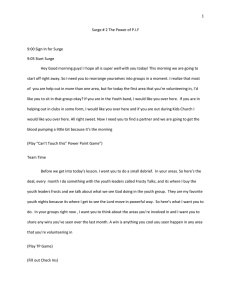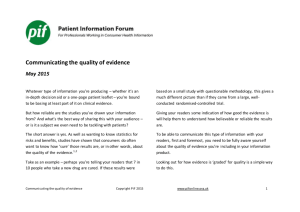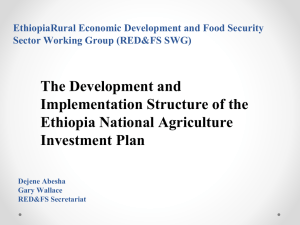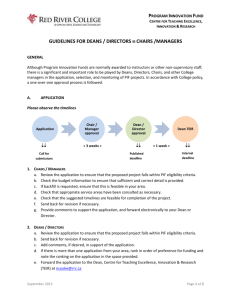Reasoning in a Human Mode
advertisement
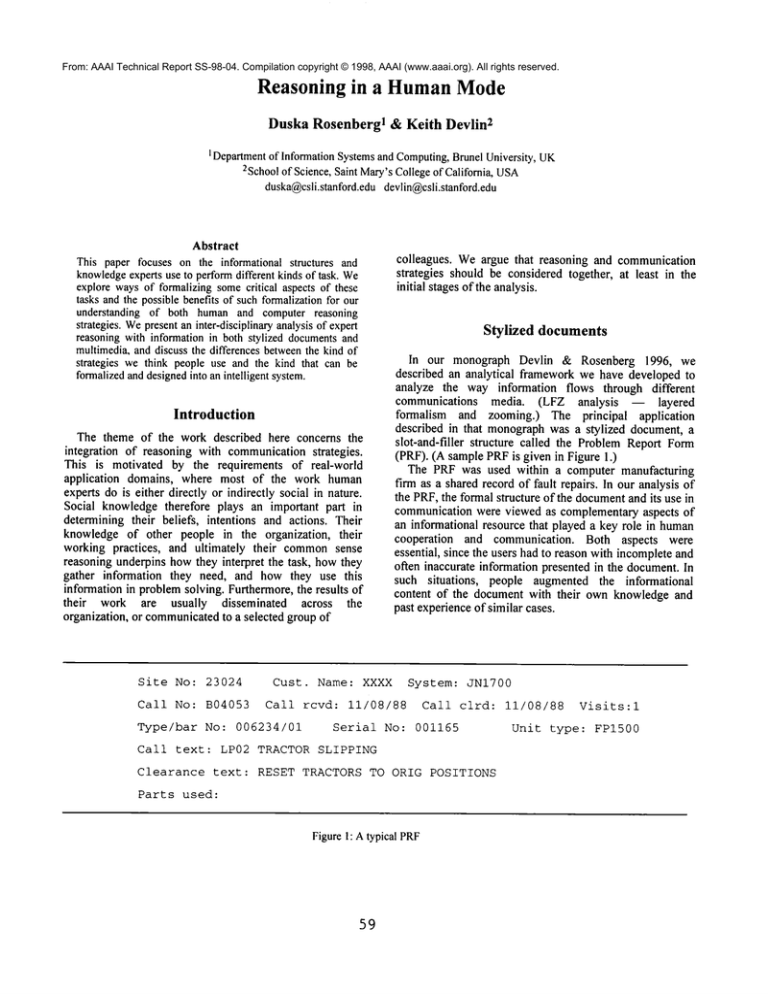
From: AAAI Technical Report SS-98-04. Compilation copyright © 1998, AAAI (www.aaai.org). All rights reserved. Reasoning in a HumanMode Duska Rosenberg 1 2& Keith Devlin 1 Departmentof InformationSystemsand Computing, BrunelUniversity, UK 2Schoolof Science,Saint Mary’sCollegeof California, USA duska@csli.stanford.edu devlin@csli.stanford.edu Abstract This paper focuses on the informational structures and knowledge experts use to performdifferent kinds of task. We explore waysof formalizing somecritical aspects of these tasks and the possiblebenefits of suchformalizationfor our understanding of both humanand computer reasoning strategies. Wepresentan inter-disciplinaryanalysisof expert reasoning with information in both stylized documentsand multimedia,and discuss the differences betweenthe kind of strategies we think people use and the kind that can be formalizedand designedinto an intelligent system. Introduction The theme of the work described here concerns the integration of reasoning with communicationstrategies. This is motivated by the requirements of real-world application domains, where most of the work human experts do is either directly or indirectly social in nature. Social knowledge therefore plays an important part in determining their beliefs, intentions and actions. Their knowledge of other people in the organization, their working practices, and ultimately their commonsense reasoning underpins howthey interpret the task, howthey gather information they need, and how they use this information in problemsolving. Furthermore, the results of their work are usually disseminated across the organization, or communicated to a selected group of Site No: 23024 colleagues. Weargue that reasoning and communication strategies should be considered together, at least in the initial stages of the analysis. Stylized documents In our monograph Devlin & Rosenberg 1996, we described an analytical frameworkwe have developed to analyze the way information flows through different communications media. (LFZ analysis -- layered formalism and zooming.) The principal application described in that monographwas a stylized document, a slot-and-filler structure called the ProblemReport Form (PRF). (A samplePRFis given in Figure 1 The PRF was used within a computer manufacturing firm as a shared record of fault repairs. In our analysis of the PRF,the formal structure of the documentand its use in communication were viewed as complementary aspects of an informational resource that played a key role in human cooperation and communication. Both aspects were essential, since the users had to reason with incompleteand often inaccurate information presented in the document.In such situations, people augmented the informational content of the document with their own knowledge and past experienceof similar cases. Cust. Name: XXXX System: JNI700 Call No: B04053 Call rcvd: 11/08/88 Call clrd: Type/bar No: 006234/01 Serial No: 001165 Call text: LP02 TRACTOR SLIPPING Clearance text: RESET TRACTORS TO ORIG POSITIONS Parts used: Figure! : Atypical PRF 59 11/08/88 Visits:l Unit type: FPI500 Our work was motivated by the failure of an attempt to develop an expert system to process the information in the documents.In the tradition of advisory expert systems at the time, the PRFexpert prototype was able to work out is some detail the cost of maintaining equipment at a customer site. It provided a limited diagnostic service which helped repairmen to locate the fault, identify the appropriate repair strategy and add the numberof visits to the site as well as any spares used. The blackboard architecture used provided the frameworkfor representing different kinds of knowledgein knowledgesources and the usual reasoningstrategies for their integration. The usability of the system in this domain of application, however, was disappointing. For example, the systemprovidedprecise cost figures as the result of its calculations, but the experts did not really need such precise cost figures. They were used to checking up the numberof visits on the form and makinga rough estimate of the total cost and then decided whether the costs were justifiable or not. As the result, the expert system, although technically good, was described as ’a solution looking for problems’. The analysis presented in Devlin & Rosenberg 1996 represents an attempt to avoid this kind of mistake. Although the PRFis a small and concise document, with a fixed and simple syntax, from an informational point of view it is rich and complex.It contains sufficient information for expert readers to reconstruct the sequence of activities from the time of customercall reporting the fault, to the final completionof the form once the fault has been repaired. Depending on the accuracy and the completeness of the information given in any particular form, the PRFenables the experts to reconstruct specific events in order to "understandwhathappenedin the field’. Situation theory (Barwise and Perry 1983, Devlin i 991) provides formal mechanisms(by way of constraints between situation types) that made it possible to merge the informational content from the two sources (the document and the user) into a single informational structure. Our information-based analysis differed significantly from the more conventional approaches that abstract the generic structure from a set of records. It enabled us to make distinctions based on the informational content of the form and the contextual information users themselves bring to the task of interpretation and to consequentaction. Our analysis consisted of two parts. Wefirst captured the informational structure of the document and the mannerin which the structure enabled information to flow through the document. The ’intension of the PRF’ is a collection of infons that relate different parts of the form to one another. Whenthe form has been correctly filled in, the expert reader can identify the systemthat broke down,its owner, its location, the type of the faulty component,and the level of modification, since the structure of the form provides the relevant informational links between these items of information and, in particular, the fact that throughout the document reference is made to the same computer system. In other words, the structure of the form, captured in the documentintension, allows for a mapping(an infomorphism)to be created that anchors the informational structure of the documentintension to real objects and real situations in the world of fault reporting and repair. The other part of our analysis showed what interpretative strategies humanexperts use in order to understand what happenedin the field and, based on that understanding, to make appropriate decisions and take appropriate action. Using the conceptual frameworkof situation theory, we assume that expert readers are attuned to a set of constraints whichenable themto relate different kinds of knowledge in the course of interpretation, such as: technical domain knowledgeof computer systems, fault types and appropriate repair actions, organizational knowledge about what other people, such as repair engineers, must knowin order to do their jobs effectively, and knowledge of the PRF language, which enables them to recognize the identification of the faulty systemand the descriptions of faults and repairs. In particular, the constraints enable readers to relate the textual informationin the PRFcall text and clearance text sections to the types of fault and types of repair, whichin turn enables them to gradually build up an interpretation of specific events. Animportant point to mentionhere is that this interpretation, in the real world of decisionmakersand repair engineers, is often madeon the basis of inaccurate, incomplete, or otherwise imperfect PRF forms. Expert readers have therefore developed contingency constraints and strategies for recovering information from imperfect forms. These are captured in the diagramshownin Figure 2. Tea// Tclear Tclear Bad PFIF Scene Excluded+~+/Story . Explanation ~C-. Bad PRF Figure2: Strategies for readinga PRF 6O If the form has been filled in properly, the reader can identify the system, recognize the fault constraint from the text given in the call text section of the form, and match the fault and the repair constraints in a straightforward manner, leading to the informational category that we have called the ’scene’. Analternative path, where the fault constraint is recognized but the repair constraint was not, wouldindicate that the repair engineer did not knowhowto do his job, and in fact, such a form was never encountered. At the other end of the diagram are the interpretations that show what happens whenthe fault constraint has not beenrecognized-- if the repair constraint is clear, the reader assumesits relevance to the fault and uses his technical knowledge(denoted as EC, that is, engineer’s constraint) to ’retrieve’ the components of the ’story’ about what happened in the field on that occasion. For example,if the clearance text (whichis relevant to the repair constraint) states that the repair action was to replace paper breaks on a printer, then the reader believes that the call text should have stated that the paper breaks that were broken. If the engineer’s knowledge is not sufficient to retrieve information about the event in this way, then he may resort to other kinds of knowledgeto infer whether the people whofilled in the form were competent or whether the maintenance activity was well organized. In other words, he seeks an explanation outside the boundaries of a particular technical problem. Analysis of the PIF In our PRFstudy, the focus was not on capturing and formalizing the domain knowledgeof humanexperts and expert systems, but on the ways people communicatein the workplace and the role a knowledge-basesystem has, or could have, in this context. Situation theory provided both a conceptual frameworkand analytical tools. The About the page owner Name Address PhoneNo. Videoglance Phot s of o ice e viron ent screen Photograph S,,,,,e N,Ilkk..,, Aboutthe organization [ Vi+°’glahces~nearelst I ¸~m~ ¯ I~llt~ I I I or~anizat//::)nal nl}ighbots I le aresltnegh°rs / I I hrUnk~ n scr4ens le, k,dt~l~rr~( °fl Textualdescriptionsof relationship of eachneighborto the pageowner,with advice on whomto contact about what. Aboutthe page owner’s work Textualdescription of the work carried out by the pageowner. This part will also be multimediain due course. Figure3: AsamplePIF page, togetherwitha key 61 I I conceptual frameworkof situation theory encouragedthe perspective on the PRFas a source of information, instead of thinking of it as a structured data item in a database or a formalized discourse structure, for example. This motivated an examination of the content of individual PRFsin terms of informativeness, whichin turn led to the identification of the three maininformational categories of the PRF-- the scenes, the stories and the explanations -- where important distinctions between seemingly identical PRFscould be made. Anotherwayof looking at the results is to consider in what way and to what extent humanreasoning strategies provide the context in which system reasoning strategies may be evaluated, either from the theoretical AI perspective, or from a more practical perspective of the design of useful and usable expert systems. In contrast to the highly stylized textual nature of the PRF, the People and Information Finder (PIF) -- see Figure 3 -- is a networkof individual webpages that has been designed to provide as much information as is needed to support users’ information requirements. Multimedia and web technologies make it possible to display and create rich informational contexts from photographs of page owners and their offices, videoglances of their current activities, addresses and phone numbers,as well as virtual reality presentations of their physical environment. The amount of information and the variety of informational sources is thus much greater as well as being presented in a mannerthat makes it easy for people to integrate it into an adequate interpretation. The PIF was intended to provide a facility for making contact with people at remote sites, and then to offer a unified technological platform for the PIF-mediated communication and cooperation. From an application point of view, it was important to design the technology so that the basic operations are seamless and are carried out in real-time. Oneimportant feature was to offer page ownerssomeprotection against intrusion, since potential callers could see from the videoglance if the person was busy. To the caller, it offered a choice of channels for making contact, each with potential advantages and disadvantages. From the research perspective, it is important to consider howsuch a wealth of information is organized in specific circumstances. Howdo people reason with information from multiple sources? Howdo they integrate information presented in different media? Under what circumstances would they choose to communicate via email, and whenwouldthey prefer to phone? The empirical study of the P1F (prototype) in use was focused on the notion of "informativeness in situ" of multimedia displays, and, in particular, on the ways in which the formal structure of a PIF page allows informationto flow through it. Initially, elicitation was focusedon the features of the PIF that are most likely to be of use in makingcontact with membersof construction teams working on different sites or offices. Unstructured and semi-structured interviews were supplemented with observation of the activities in shared spaces, and it soon becameclear that the technology was having a considerably greater impact than had been expected. Direct questions aimed at eliciting patterns of use of communicationtechnology were later replaced with focus interviews, where groups of experts discussed howthey could use the technology exemplified by the PIF. These discussions provided the basis for structured role play exercises, where informants were acting out meetings "at arm’s length" to find out whether they could achieve shared goals through mediated cooperation. Task-based stories and scenarios were also enacted, and the experience provided topics for review and critique of the technologyin use. Several key observations were madein the elicitation phase. Throughout all the interactions, people were observing rules of polite behavior- for example, seeking permission to view the videoglance and interpreting what they saw. They were also constructing their ownstories and scenarios about situations shown on the screen, drawing conclusions about personalities, social relationships, or positions of individuals in the organizational hierarchy. It seemsthat people were building a stock of contexts for future use, not only to choose howto contact them, but also howto formulate requests for information and howto approach the ownerabout a confidential matter. In other words, they were creating a number of "what-if" situations as if they were rehearsing alternative outcomes of future interactive situations. Thus, the work which started almost as a routine phase in the design and implementationof the PIF, openedup a numberof issues of both theoretical and practical nature. The observations of people using the PIF suggested directions for further investigation of information processing strategies, where humanability to handle ’all and only’ valid linguistic structures is an integral part of their communicative competence. The status of the PIF has, quite unexpectedly, changed from a piece of technologyto a potentially novel elicitation tool, capable of bringing out in the open the tacit shared understanding of the communicative situations users jointly create. Formalstructure of the PIF As a designed artifact, the PIF has a defined formal structure. But its use as a shared informational resource depends on its ’fit’ with the way people handle information. In this section, we present the initial stages of our explorationinto the nature of this fit. 62 Whenan expert reads a text documentsuch as a PRF, the information the expert acquires helps to create a context for further action. For the purposes of analysis of the way the document functions, however, it is most natural, and has hitherto proved most useful, to view the documentas a mediumfor the transmittal of information, and investigate what information the documentactually conveys and in what manner. In the case of a multimedia documentsuch as the PIF, on the other hand, it appears more natural, and, we suspect, will turn out to be more useful, to view the process as one of creating a context for further action. In situation-theoretic terms, whereasour analysis of the PRFas a document(as opposed to the way the PRFwas used) was essentially at the level of infons, our analysis of the PIF as a documentwill be in large part in terms of situations¯ Another way of expressing the above point is that, whereas we can see (and indeed have demonstrated) benefit in analyzing a textual documentsuch as the PRF at the familiar levels of syntax, semantics, and use, for a multimedia document such as the PIF we believe that a meaningfuland useful analysis can only be at the level of investigation. In this overview, we simply indicate the general idea. First, we define an infonic ’intension’ of the PIF, to capture the various connections between the different components. This is analogous to the intension of the PRF; we shall give the details in a muchlonger version of this article, currently in preparation. We regard each of the photographs and the videoglances in a PIF as a situation. In particular, we do not, at this stage, distinguish betweena photographor a videoglance and the original person or scene. Weregard the photograph or videoglance mechanismon the PIF as a cognitive tool that extends the users visual reach. Textual componentsof the PIF require interpretation, of course. Thoseinterpretations will be compound infons. If u is the context in which a user interacts with the PIF, if u l ..... un are the photographsand videoglances in the PIF, if ~-_Yisthe intension of the PIF, and if~1 ..... ~m are the infons corresponding to the textual componentsof the PIF, then we define a hull of Ul ..... Un over u with respect to the intension ~ and the infons Ol, ¯ ¯ ¯, ~mto be a minimalsituation v such that u, Ul, ¯ ¯ ¯, Unare all subsituations ofv and v I=~Y&cl&...&~m (Notice that there is no claim that the hull is unique. See Devlin 1991for a discussion of this kind of definition.) Then,ull~llv. The next stage of the analysis examines the way the properties of the hull dependon the properties of u, u 1, ¯ ¯ use¯ To use terminology introduced by Dretske (1981), the photographs and videoglances in a PIF provide the user with ’analog’ information, as opposed to the ’digital’ information provided by text such as in a PRF. (These are technical uses of the words ’analog’ and ’digital’ that Dretske takes some effort to define. Roughlyspeaking, analog information is capable of endless refinement, whereasdigital information is discrete¯ The introduction of infons in situation theory (Devlin 1991) was intended as a means of capturing digital information within a mathematical framework¯) By analogy with the way we analyzed the use of the PRFs, we shall associate with each PIF screen ~p an entity IIg, ll, called the utility of~. The utility is a two-place relation betweensituations. If u is a situation in whicha persona interacts with the PIF 0p (i.e., ifu is the contextin which a interacts with ~ ), then ull~llv,where v is the situation that providesthe context for a’s next action¯ By identifying the utility as the principal ’semantic’ (mathematical) entity associated with a PIF, we establish the frameworkfor the next stage of our analysis. As was the case for the PRF, the analysis uses our LFZ methodology. As we argued in Devlin and Rosenberg 1996, it is in general not possible to analyze the human activities of communication and cognition in a reductionist fashion that eventually ’bottomsout’. This is the key observation that distinguishes LFZanalysis from other analytic techniques that use mathematics. An LFZ analysis comprises a starting point and the frameworkfor an iterative process of refinement. In the case of the PIFs, the next stage involves an examinationof the mannerin which the utility IlOl[ of a PIF 0 arises from the various componentsof the PIF page. The exact details dependon the specific usage data under ¯, Un,~_7, ~1, ¯ ¯ ¯, ~m. That, at least, is the general idea. Thereare a numberof technical issues that depend on the exact data under consideration, and whichwe are glossing over in this brief overview. References Barwise, J and Perry, J, Situations and Attitudes, Cambridge, MA:Bradford Books, MITPress (1983) Devlin, K, Logic and Information, CambridgeUniversity Press (1991) Cambridge, UK: Devlin, K and Rosenberg, D, Language at Work: Analyzing Communication Breakdown in the Workplace to Inform Systems Design, Stanford, CA: CSLI Lecture Notes 66, CSLIPublications (1996) Dretske, F, Knowledge and the Flow of Information, Oxford, UK: Blackwell (1981) A demonstration version of the PIF can be viewed at the CICCweb site, URL http://www.hhdc.bicc.com/cicc/glance.htm Click on the link markedDavid Leevers. 63

